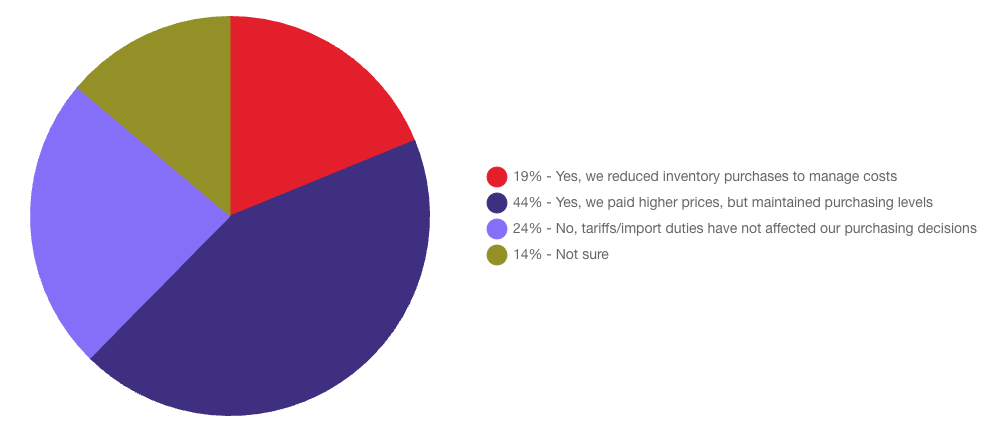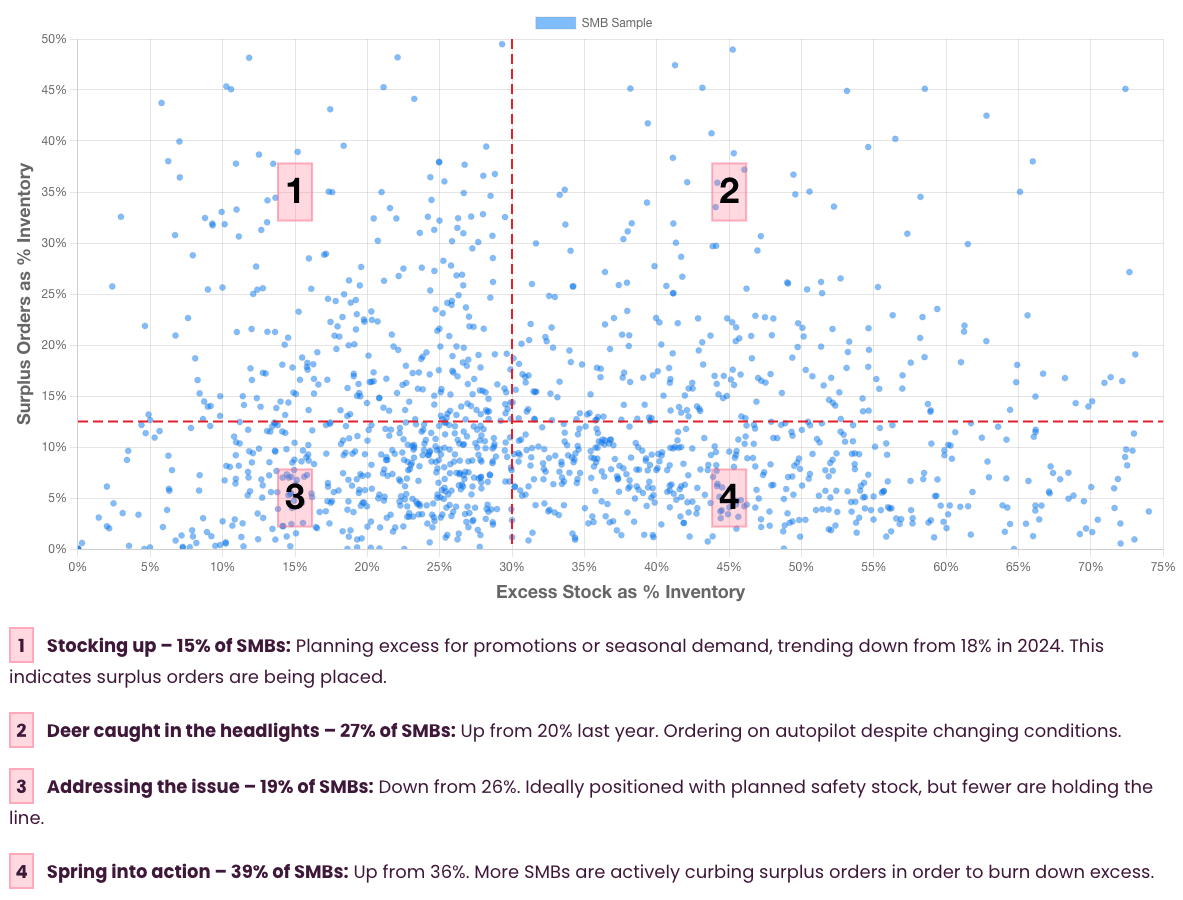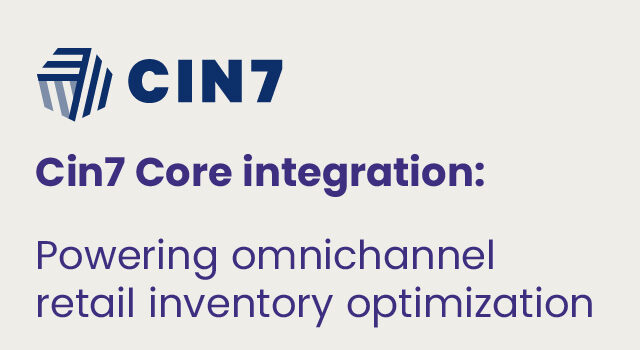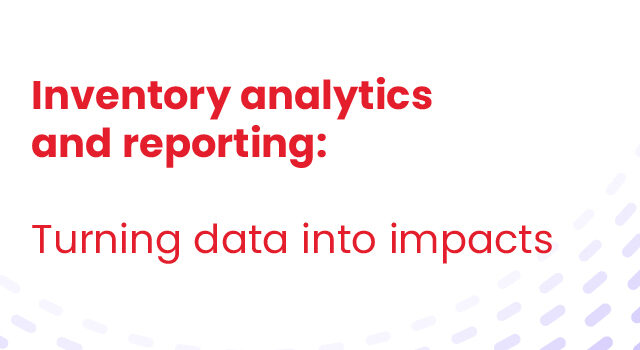For small and medium-sized businesses (SMBs), 2024 was a year of reaction, but 2025 tells a different story. Netstock’s 2025 Benchmark Report captures this with data and insights only possible from 15+ years of experience in supply chains.
Drawing on insights from over 130 SMBs and aggregated data from our global customer base of 2,400+ companies, this year’s findings reveal how businesses are turning chaos into competitive advantage; using technology to forecast with confidence, optimize inventory with precision, and navigate uncertainty with clarity.
“What we’re seeing is SMBs leveraging strategies and technologies once reserved for large enterprises. AI is at the center of that shift.” – Jefferson Barr, CMO of Netstock
What’s in this blog?
Quick insights
Here are the headlines from the report published on October 16 that are key moments from 2025’s supply chain landscape:
- 63% of SMBs faced direct tariff impacts, with most choosing to absorb costs rather than risk customer loss.
- AI adoption doubled, with 48% of SMBs now using AI tools in their supply chain operations.
- Service levels above 90% rose from 41% to 46%, showing resilience despite external pressures.
- 93% launched or expanded product lines in 2025, proving that disruption doesn’t have to stall innovation.
- Supplier collaboration surged, with VMI adoption jumping from 29% to 44% and consignment growing from 19% to 25%.
2025: From disruption to discipline
2025 was about reaction, that is: tariff announcements, supply shocks, demand changes, and more. This year is about building systems that can handle these unpredictable shifts.
SMBs learned hard lessons in late 2024. They discovered that spreadsheets couldn’t keep up with rapid change. They watched cash get stuck in excess inventory while stockouts cost them sales at the same time. They felt rising costs and tightening credit squeezed their operations.
But SMBs are reporting that those lessons are turning into action. More businesses are investing in forecasting tools, using AI to optimize inventory decisions faster, rethinking supplier relationships, and exploring models that share risk across the supply chain.
Tariffs rewrite the rules for SMBs
Tariffs dominated the first half of 2025. A staggering 63% of SMBs reported direct operational effects. How are they handling it? The most common answer: absorb the cost. Nearly half of SMBs (44%) chose to take the margin hit rather than pass increases to customers or risk stockouts. This decision reveals a critical priority: maintaining service levels and customer relationships mattered more than protecting short-term profits.
These tariff shocks are reshaping long-term strategies. Reliance on long-term supplier contracts fell from 47% to 36%. Sourcing decisions shifted, too. Split sourcing dropped nearly 10%. Offshore reliance dipped from 31% to 28% while domestic sourcing climbed by 2%. These may signal early reshoring trends or simply reflect tighter budgets.
Supply chain insights highlight the rise of “strategic stock”
As our new supply chain planning report highlights, inventory behavior in 2025 tells two competing stories. On one hand, 30% of SMBs now classify a significant portion of their excess stock as “strategic” – deliberately held as a buffer against tariffs, delays,demand surges, or other unforeseen events. On the other hand, dead stock is climbing. Today, 17% of SMBs report that more than 10% of their inventory sits unsold for long periods, up from 12% in 2024.
In all industries, SMBs have competing opinions on how to handle excess stock.
Reality check in the world of supply chain planning
With tariffs in the headlines, supplier performance issues compounded for many SMBs this past year. And the pain hasn’t eased. Lead time variability remains the top challenge for businesses, reported by 68%. Cost, though important, ranked lower with just under half (48%) of SMBs citing it as a challenging reality for their operations.
2025 has also been the year in which modest efficiency improvements of previous quarters have stabilized. As cited in the recent Benchmark Report:
“Global stock turns plateaued in 2025, holding an average of 5.3 and a median of 3.9 — almost unchanged from last year. The gap between the mean and median highlights a familiar story: a small group of high performers keep inventory moving efficiently, while most SMBs continue to struggle to accelerate sell-through. Despite the tariff pressures of late 2024, there was no broad improvement in turnover, suggesting that momentum has stalled. For some SMBs, stability may feel like a win, but for others, sluggish stock turns remain a drag on cash flow and competitiveness.”
The AI tipping point: From concept to capability
AI has crossed a threshold in 2025. Adoption more than doubled, climbing from 23% to 48%, while future investment plans jumped from 26% to 49%. Perhaps most tellingly, only 17% now say they’re unsure about AI investment, down from 47% a year ago.
According to Netstock’s customers, AI use cases have increased in 2025, compared to 2024.
| AI Use Case | 2024 | 2025 |
| Demand planning | 44% | 55% |
| Inventory optimization | 48% | 58% |
| Forecasting | 52% | 63% |
| Supplier performance | 20% | 27% |
Of course, supply chain challenges remain. Security concerns, inconsistent answers, and transparency issues were all reported. Still, progress is visible. Fewer SMBs cite “not knowing how AI works” compared to last year, showing that education and familiarity are building confidence.
The most striking finding? More than 75% of SMBs are now willing to share or delegate inventory processes to AI. This readiness signals a maturing relationship with technology. SMBs recognize AI’s potential to handle routine decisions, flag exceptions, and model scenarios faster than human analysts. The year 2025 marks the moment when AI became real for SMBs: not hype, but hands-on progress.
More supply chain insights from the 2025 Benchmark Report
These are just some of the in-depth insights on the state of supply chains captured in Netstock’s 2025 Benchmark Report. For more insights on how tariffs are rewriting the playbook, the inventory balancing act SMBs are being forced to play, or how AI adoption is poised to change the story yet again in 2026, read the full report.





